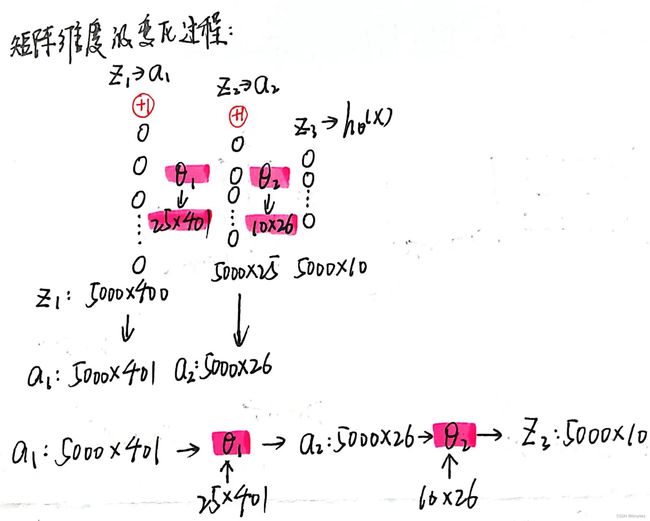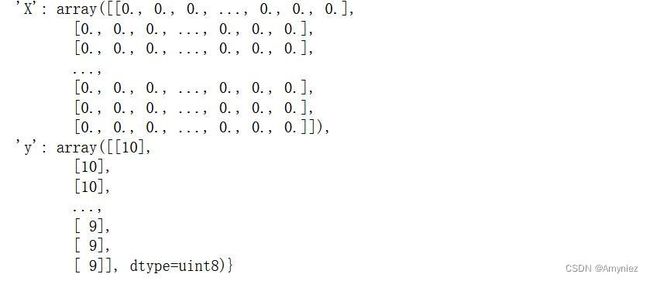机器学习笔记 十:基于神经网络算法的数据预测
目录
-
- 1.数据导入及y样本集的处理
- 2. 前向传播算法实现(正则化)
- 3.后向传播算法
- 4.最小化目标函数(cost function)
- 5.预测新样本
本次的数据集为手写体数据
1.数据导入及y样本集的处理
import numpy as np
import pandas as pd
import matplotlib.pyplot as plt
from scipy.io import loadmat
from sklearn.preprocessing import OneHotEncoder
data = loadmat('E:\\MachineLearning\\PythonSet\\number.mat')
# sklearn中的OneHotEncoder,将y(向量):5000*1转换为 y:5000*10的矩阵
# 所以这里不用向MATLAB一样,编写一个程序实现onehot功能
encoder = OneHotEncoder(sparse=False)
y_onehot = encoder.fit_transform(y)
y_onehot.shape
数据查看:
X = data['X']
y = data['y']
X.shape, y.shape
((5000, 400), (5000, 1))
2. 前向传播算法实现(正则化)
# sigmoid function
def sigmoid(z):
return 1 / (1 + np.exp(-z))
# forward propagate function
def forward_propagate(X, theta1, theta2):
# 计算样本数5000个(0:行数,1:列数)
m = X.shape[0]
# axis=0:在行方向上插入,1:在列方向上插入
a1 = np.insert(X, 0, values=np.ones(m), axis=1)
z2 = a1 * theta1.T
# 在a2矩阵前插入1
a2 = np.insert(sigmoid(z2), 0, values=np.ones(m), axis=1)
z3 = a2 * theta2.T
h = sigmoid(z3)
return a1, z2, a2, z3, h
# cost function(正则化)
def cost_reg(params, input_size, hidden_size, num_labels, X, y, learning_rate):
m = X.shape[0]
X = np.matrix(X)
y = np.matrix(y)
# 将参数数组重塑为参数矩阵
theta1 = np.matrix(np.reshape(params[:hidden_size * (input_size + 1)], (hidden_size, (input_size + 1)))) # 重塑为 25*401
theta2 = np.matrix(np.reshape(params[hidden_size * (input_size + 1):], (num_labels, (hidden_size + 1)))) # 重塑为 10*26
# 运行前向传播算法
a1, z2, a2, z3, h = forward_propagate(X, theta1, theta2)
# 计算代价
J = 0
# 循环5000次
for i in range(m):
first_term = np.multiply(-y[i,:], np.log(h[i,:]))
second_term = np.multiply((1 - y[i,:]), np.log(1 - h[i,:]))
J += np.sum(first_term - second_term)
J = J / m
# 进行正则化处理(防止过拟合)
J += (float(learning_rate) / (2 * m)) * (np.sum(np.power(theta1[:,1:], 2)) + np.sum(np.power(theta2[:,1:], 2))) # 计算theta1和theta2的平方之和
return J
# 初始化设置
input_size = 400
hidden_size = 25
num_labels = 10
learning_rate = 10
# 随机初始化参数矩阵theta1、theta2
params = (np.random.random(size=hidden_size * (input_size + 1) + num_labels * (hidden_size + 1)) - 0.5) * 0.25
m = X.shape[0]
X = np.matrix(X)
y = np.matrix(y)
# 将参数数组解开为每个层的参数矩阵
theta1 = np.matrix(np.reshape(params[:hidden_size * (input_size + 1)], (hidden_size, (input_size + 1))))
theta2 = np.matrix(np.reshape(params[hidden_size * (input_size + 1):], (num_labels, (hidden_size + 1))))
theta1.shape, theta2.shape
((25, 401), (10, 26))
a1, z2, a2, z3, h = forward_propagate(X, theta1, theta2)
a1.shape, z2.shape, a2.shape, z3.shape, h.shape
((5000, 401), (5000, 25), (5000, 26), (5000, 10), (5000, 10))


我认为上面所求的矩阵的维度是非常重要的,它能够帮助我们理清前向传播的思路,需要重点关注此处!!!
cost_reg(params, input_size, hidden_size, num_labels, X, y_onehot, learning_rate)
cost:6.95374626979026
3.后向传播算法
# sigmoid函数梯度(导数):y * (1-y)
def sigmoid_gradient(z):
return np.multiply(sigmoid(z), (1 - sigmoid(z)))
# 反向传播算法BP:
def backprop(params, input_size, hidden_size, num_labels, X, y, learning_rate):
m = X.shape[0]
X = np.matrix(X)
y = np.matrix(y)
# 将参数数组重塑为参数矩阵
theta1 = np.matrix(np.reshape(params[:hidden_size * (input_size + 1)], (hidden_size, (input_size + 1))))
theta2 = np.matrix(np.reshape(params[hidden_size * (input_size + 1):], (num_labels, (hidden_size + 1))))
# 运行前向传播算法
a1, z2, a2, z3, h = forward_propagate(X, theta1, theta2)
# initializations
# 获得正确的参数delta的维度
J = 0
delta1 = np.zeros(theta1.shape) # (25, 401)
delta2 = np.zeros(theta2.shape) # (10, 26)
# 计算代价
for i in range(m):
first_term = np.multiply(-y[i,:], np.log(h[i,:]))
second_term = np.multiply((1 - y[i,:]), np.log(1 - h[i,:]))
J += np.sum(first_term - second_term)
J = J / m
# 正则化
J += (float(learning_rate) / (2 * m)) * (np.sum(np.power(theta1[:,1:], 2)) + np.sum(np.power(theta2[:,1:], 2)))
# 计算后向传播算法BP
for t in range(m):
a1t = a1[t,:] # (1, 401)
z2t = z2[t,:] # (1, 25)
a2t = a2[t,:] # (1, 26)
ht = h[t,:] # (1, 10),预测值
yt = y[t,:] # (1, 10),实际值
d3t = ht - yt # (1, 10)
z2t = np.insert(z2t, 0, values=np.ones(1)) # (1, 26)
# np.multiply():元素乘法,非矩阵乘法
d2t = np.multiply((theta2.T * d3t.T).T, sigmoid_gradient(z2t)) # (1, 26)
delta1 = delta1 + (d2t[:,1:]).T * a1t
delta2 = delta2 + d3t.T * a2t
delta1 = delta1 / m
delta2 = delta2 / m
# 正则化
delta1[:,1:] = delta1[:,1:] + (theta1[:,1:] * learning_rate) / m
delta2[:,1:] = delta2[:,1:] + (theta2[:,1:] * learning_rate) / m
# unravel the gradient matrices into a single array
grad = np.concatenate((np.ravel(delta1), np.ravel(delta2)))
return J, grad
J, grad = backprop(params, input_size, hidden_size, num_labels, X, y_onehot, learning_rate)
J, grad.shape
(6.95374626979026, (10285,))
4.最小化目标函数(cost function)
from scipy.optimize import minimize
# 最小化目标函数(cost function)
# 该过程比较耗时
fmin = minimize(fun=backprop, x0=params, args=(input_size, hidden_size, num_labels, X, y_onehot, learning_rate),
method='TNC', jac=True, options={'maxiter': 250})
fmin
 这里的代价为0.99,虽然不是很低,但是对于这个例子来说也足够了,如果想让代价更低一些,可以调整学习率来实现。
这里的代价为0.99,虽然不是很低,但是对于这个例子来说也足够了,如果想让代价更低一些,可以调整学习率来实现。
5.预测新样本
# 使用前向传播算法对新样本进行预测
X = np.matrix(X)
theta1 = np.matrix(np.reshape(fmin.x[:hidden_size * (input_size + 1)], (hidden_size, (input_size + 1))))
theta2 = np.matrix(np.reshape(fmin.x[hidden_size * (input_size + 1):], (num_labels, (hidden_size + 1))))
a1, z2, a2, z3, h = forward_propagate(X, theta1, theta2)
y_pred = np.array(np.argmax(h, axis=1) + 1)
correct = [1 if a == b else 0 for (a, b) in zip(y_pred, y)]
accuracy = (sum(map(int, correct)) / float(len(correct)))
print ('accuracy = {0}%'.format(accuracy * 100))
accuracy = 93.76%


